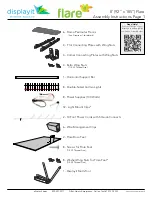
Cleaning
17
Deutsch
English
Nederl
ands
Franç
a
is
Itali
a
no
Esp
a
ñol
Dansk
Cleaning
You will be able to extend the useful life of the TFT monitor by the following measures:
Important!
No
parts to be maintained
or cleaned are located within the monitor casing.
Always pull out the mains plug and all connecting cables before cleaning.
Do not use any solvents, corrosive or gaseous cleaning substances .
Clean the screen with a soft, fluff-free cloth.
Pay attention that
no drops of water
remain on the TFT monitor. Water can cause long-lasting
discolouring.
Do not subject the screen to either dazzling sunlight or to ultra-violet radiation.
Please keep the packaging material and use this exclusively to transport the TFT monitor.
Disposal
Packaging
Your device is in packaging for protection against transport damage. Packaging is made from
materials that can be disposed off in an environmentally friendly way and taken to correct recycling.
Device
Do not throw the device into the normal domestic refuse after the end of its useful life under any
circumstances. Obtain
information about the possibilities of environmentally friendly and correct disposal.
Pixel defects on screens
For active matrix TFTs with a resolution of
1920 x 1080 pixels
, which are each made up of three sub-pixels (red,
green, blue), there are a total of
approx. 6.2 million
control transistors in use. Occasionally one or more pixels
can fail or become incorrectly controlled because of this very high number of transistors and the associated
extremely complex manufacturing processes used.
In the past, there were consistently a wide variety of approaches available for defining the permitted number of
pixel defects. However, these approaches were mostly very complicated and completely different from one
manufacturer to the next. In the handling of warranty issues for all of its display products, MEDION adheres
therefore to the strict and transparent requirements of the standard
ISO 9241-307, class II
, which has been briefly
summarised below.
The ISO standard ISO 9241-307 defines, amongst other things,
generally valid guidelines in relation to pixel defects. Pixel
defects are categorised into four classes of defect and three types
of defect. Every individual pixel consists of three sub-pixels, each
of which is assigned a basic colour (red, green, blue).
Содержание Akoya P54016
Страница 21: ...Deutsch 20 ...
Страница 41: ...English 20 ...
Страница 81: ...Français 20 ...
Страница 101: ...Italiano 20 ...
Страница 121: ...Español 20 ...
Страница 141: ...Dansk 20 ...
















































